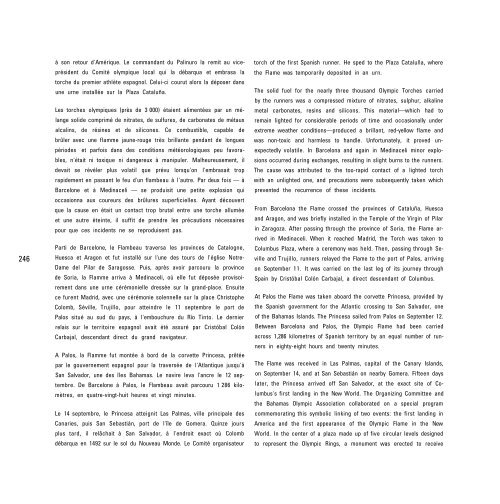Mexico City Olympic Games Official Report ... - LA84 Foundation
Mexico City Olympic Games Official Report ... - LA84 Foundation
Mexico City Olympic Games Official Report ... - LA84 Foundation
Create successful ePaper yourself
Turn your PDF publications into a flip-book with our unique Google optimized e-Paper software.
246<br />
à son retour d'Amérique. Le commandant du Palinuro la remit au vice-<br />
président du Comité olympique local qui la débarqua et embrasa la<br />
torche du premier athlète espagnol. Celui-ci courut alors la déposer dans<br />
une urne installée sur la Plaza Cataluña.<br />
Les torches olympiques (près de 3 000) étaient alimentées par un mé-<br />
lange solide comprimé de nitrates, de sulfures, de carbonates de métaux<br />
alcalins, de résines et de silicones. Ce combustible, capable de<br />
brûler avec une flamme jaune-rouge très brillante pendant de longues<br />
périodes et parfois dans des conditions météorologiques peu favora-<br />
bles, n'était ni toxique ni dangereux à manipuler. Malheureusement, il<br />
devait se révéler plus volatil que prévu lorsqu'on l'embrasait trop<br />
rapidement en passant le feu d'un flambeau à l'autre. Par deux fois — à<br />
Barcelone et à Medinaceli — se produisit une petite explosion qui<br />
occasionna aux coureurs des brûlures superficielles. Ayant découvert<br />
que la cause en était un contact trop brutal entre une torche allumée<br />
et une autre éteinte, il suffit de prendre les précautions nécessaires<br />
pour que ces incidents ne se reproduisent pas.<br />
Parti de Barcelone, le Flambeau traversa les provinces de Catalogne,<br />
Huesca et Aragon et fut installé sur l'une des tours de l'église Notre-<br />
Dame del Pilar de Saragosse. Puis, après avoir parcouru la province<br />
de Soria, la Flamme arriva à Medinaceli, où elle fut déposée provisoi-<br />
rement dans une urne cérémonielle dressée sur la grand-place. Ensuite<br />
ce furent Madrid, avec une cérémonie solennelle sur la place Christophe<br />
Colomb, Séville, Trujillo, pour atteindre le 11 septembre le port de<br />
Palos situé au sud du pays, à l'embouchure du Río Tinto. Le dernier<br />
relais sur le territoire espagnol avait été assuré par Cristóbal Colón<br />
Carbajal, descendant direct du grand navigateur.<br />
A Palos, la Flamme fut montée à bord de la corvette Princesa, prêtée<br />
par le gouvernement espagnol pour la traversée de l'Atlantique jusqu'à<br />
San Salvador, une des îles Bahamas. Le navire leva l'ancre le 12 sep-<br />
tembre. De Barcelone à Palos, le Flambeau avait parcouru 1 286 kilo-<br />
mètres, en quatre-vingt-huit heures et vingt minutes.<br />
Le 14 septembre, le Princesa atteignit Las Palmas, ville principale des<br />
Canaries, puis San Sebastián, port de l'île de Gomera. Quinze jours<br />
plus tard, il relâchait à San Salvador, à l'endroit exact où Colomb<br />
débarqua en 1492 sur le sol du Nouveau Monde. Le Comité organisateur<br />
torch of the first Spanish runner. He sped to the Plaza Cataluña, where<br />
the Flame was temporarily deposited in an urn.<br />
The solid fuel for the nearly three thousand <strong>Olympic</strong> Torches carried<br />
by the runners was a compressed mixture of nitrates, sulphur, alkaline<br />
metal carbonates, resins and silicons. This material—which had to<br />
remain lighted for considerable periods of time and occasionally under<br />
extreme weather conditions—produced a brillant, red-yellow flame and<br />
was non-toxic and harmless to handle. Unfortunately, it proved un-<br />
expectedly volatile. In Barcelona and again in Medinaceli minor explo-<br />
sions occurred during exchanges, resulting in slight burns to the runners.<br />
The cause was attributed to the too-rapid contact of a lighted torch<br />
with an unlighted one, and precautions were subsequently taken which<br />
prevented the recurrence of these incidents.<br />
From Barcelona the Flame crossed the provinces of Cataluña, Huesca<br />
and Aragon, and was briefly installed in the Temple of the Virgin of Pilar<br />
in Zaragoza. After passing through the province of Soria, the Flame ar-<br />
rived in Medinaceli. When it reached Madrid, the Torch was taken to<br />
Columbus Plaza, where a ceremony was held. Then, passing through Se-<br />
ville and Trujillo, runners relayed the Flame to the port of Palos, arriving<br />
on September 11. It was carried on the last leg of its journey through<br />
Spain by Cristóbal Colón Carbajal, a direct descendant of Columbus.<br />
At Palos the Flame was taken aboard the corvette Princesa, provided by<br />
the Spanish government for the Atlantic crossing to San Salvador, one<br />
of the Bahamas Islands. The Princesa sailed from Palos on September 12.<br />
Between Barcelona and Palos, the <strong>Olympic</strong> Flame had been carried<br />
across 1,286 kilometres of Spanish territory by an equal number of run-<br />
ners in eighty-eight hours and twenty minutes.<br />
The Flame was received in Las Palmas, capital of the Canary Islands,<br />
on September 14, and at San Sebastián on nearby Gomera. Fifteen days<br />
later, the Princesa arrived off San Salvador, at the exact site of Co-<br />
lumbus's first landing in the New World. The Organizing Committee and<br />
the Bahamas <strong>Olympic</strong> Association collaborated on a special program<br />
commemorating this symbolic linking of two events: the first landing in<br />
America and the first appearance of the <strong>Olympic</strong> Flame in the New<br />
World. In the center of a plaza made up of five circular levels designed<br />
to represent the <strong>Olympic</strong> Rings, a monument was erected to receive
















